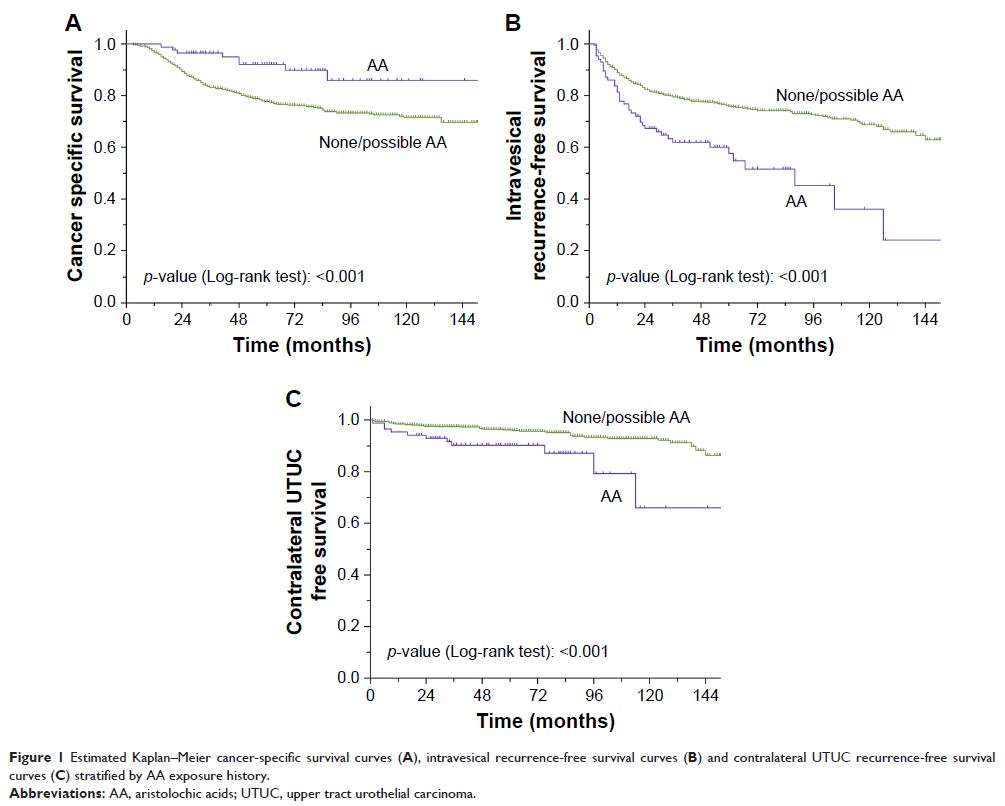108384
论文已发表
注册即可获取德孚的最新动态
IF 收录期刊
- 3.4 Breast Cancer (Dove Med Press)
- 3.2 Clin Epidemiol
- 2.6 Cancer Manag Res
- 2.9 Infect Drug Resist
- 3.7 Clin Interv Aging
- 5.1 Drug Des Dev Ther
- 3.1 Int J Chronic Obstr
- 6.6 Int J Nanomed
- 2.6 Int J Women's Health
- 2.9 Neuropsych Dis Treat
- 2.8 OncoTargets Ther
- 2.0 Patient Prefer Adher
- 2.2 Ther Clin Risk Manag
- 2.5 J Pain Res
- 3.0 Diabet Metab Synd Ob
- 3.2 Psychol Res Behav Ma
- 3.4 Nat Sci Sleep
- 1.8 Pharmgenomics Pers Med
- 2.0 Risk Manag Healthc Policy
- 4.1 J Inflamm Res
- 2.0 Int J Gen Med
- 3.4 J Hepatocell Carcinoma
- 3.0 J Asthma Allergy
- 2.2 Clin Cosmet Investig Dermatol
- 2.4 J Multidiscip Healthc

马兜铃酸暴露对根治性肾切除术后上尿路上皮癌肿瘤转归的影响
Authors Zhong W, Zhang L, Ma J, Shao S, Lin R, Li X, Xiong G, Fang D, Zhou L
Received 8 August 2017
Accepted for publication 11 October 2017
Published 5 December 2017 Volume 2017:10 Pages 5775—5782
DOI https://doi.org/10.2147/OTT.S148641
Checked for plagiarism Yes
Review by Single-blind
Peer reviewers approved by Dr Akshita Wason
Peer reviewer comments 2
Editor who approved publication: Dr XuYu Yang
Objective: To investigate the effect of aristolochic acids (AA) exposure,
including exposure duration and years since last exposure, on oncologic
outcomes of patients with upper tract urothelial carcinoma (UTUC) after radical
nephroureterectomy (RNU).
Methods: We retrospectively collected clinicopathologic and AA exposure variables
for 942 UTUC patients treated with RNU between 1999 and 2014 in a high-volume
center of China. AA exposure duration was categorized as (>3 vs ≤3 years)
and time since last AA exposure to surgery as (>5 vs ≤5 years).
Results: A total of 856 patients (90.9%) had none or possible AA exposure
and 86 patients (9.1%) had credible AA exposure history. Among the 86 patients,
57 (66.3%) had AA exposure for ≤3 years and 29 (33.7%) had exposure for >3
years. The median follow-up duration was 60 months. By multivariate analysis,
AA exposure history was significantly associated with cancer specific survival
(hazard ratio [HR]: 0.43, p =0.02),
intravesical recurrence (IVR) (HR: 2.25, p <0.001)
and contralateral UTUC recurrence (HR: 2.71, p =0.001).
After adjusted for the effects of standard clinicopathologic characteristics,
exposure duration was independent risk factor for subsequent IVR (exposure
duration ≤3 years vs none/possible AA, HR: 1.87, p =0.009; exposure duration >3
years vs none/possible AA, HR: 3.07, p <0.001), but
not for cancer-specific survival (p =0.06). Also, of
those patients who had AA exposure, those having exposure within 5 years prior
to RNU did not differ from patients having last exposure >5 years ago
regarding cancer specific mortality (p =0.67) and IVR (p =0.54).
Conclusion: AA exposure was associated with worse cancer-specific survival, higher
rate of IVR and contralateral UTUC recurrence of UTUC treated with RNU. The
association between AA exposure and IVR seems to be time-dependent. Exposure
cessation >5 years prior to RNU cannot mitigate the impact of AA on the UTUC
prognosis.
Keywords: aristolochic acid, urothelial carcinoma, upper urinary tract, radical
nephroureterectomy, survival, prognosis
